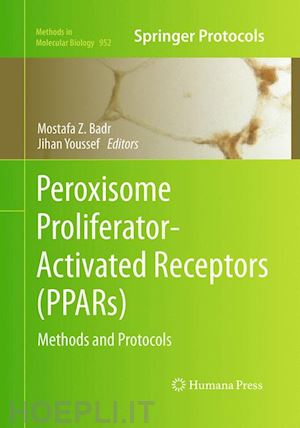
Questo prodotto usufruisce delle SPEDIZIONI GRATIS
selezionando l'opzione Corriere Veloce in fase di ordine.
Pagabile anche con Carta della cultura giovani e del merito, 18App Bonus Cultura e Carta del Docente
All three peroxisome proliferator-activated receptor (PPAR) subtypes share a high degree of structural homology but differ in function, tissue distribution and ligand specificity. PPARs play critical roles as regulators of numerous physiological as well as pathophysiological pathways, and efforts are currently underway to fully characterize their functioning and to develop safer and more effective PPAR modulators to treat a myriad of diseases and conditions. In Peroxisome proliferator-Activated Receptors: Methods and Protocols, renowned experts in the PPAR arena provide detailed protocols for investigating these receptors. Chapters contain methods ranging from the cloning of receptors to their knockdown, to protocols exploring posttranslational modifications of PPARs and coactivators, as well as receptor subcellular localization. Also assembled are methods to evaluate the involvement of these receptors in behavior functions, an emerging facet in PPAR research. Written in the successful Methods in Molecular Biology™ series format, chapters include introductions to their respective topics, lists of the necessary materials and reagents, step-by-step, readily reproducible protocols, and notes on troubleshooting and avoiding known pitfalls.
With its well-honed methodologies, Peroxisome proliferator-Activated Receptors: Methods and Protocols, will be a useful resource for all seeking to advance their knowledge of this field.
1. PPARs: History and Advances
Jihan Youssef and Mostafa Badr
2. PPAR-Alpha Cloning, Expression and Characterization
Suong N. T. Ngo and Ross McKinnon
3. PPARGC1A and PPARG Genotyping. Beginner’s Guide to Genotyping with Unlabeled Probes
Viera Habalova and Josef Židzik
4. Generation of an Inducible, Cardiomyocyte-Specific Transgenic Mouse Model with PPARß/d Overexpression
Teayoum Kim, Olga Zhelyabovska, Jian Liu, and Qinglin Yang
5. Specific knockdown of PPARd Gene in Colon Cancer Cells by Lentivirus-Mediated RNA Interfering
Lie Yang, Zong-Guang Zhou, and Xiao-Feng Sun
6. Dominant-Negative and Knockdown Approaches to Studying PPAR activity
Sudhir Singh and Robert G. Bennett
7. Producing PPARgamma2 Knockdown in Mouse Liver
Tomomi Yamazaki and Osamu Ezaki
8. Adipose Tissue-Specific PPARg Gene Targeting
Weimin He
9. Site-Directed Mutagenesis to Study the Role of Specific Amino Acids in the Ligand Binding Domain of PPARs
Nico Mitro, Frederica Gilardi, Marco Giudici, Cristina Godio, Elena Scotti, and Maurizio Crestani
10. PPAR SUMOylation: Some Useful Experimental Tips
Benoit Pourcet, Bart Staels, and Corine Glineur
11. Analyzing Phosphorylation-Dependent Regulation of Subcellular Transcriptional Activity of Transcriptional Coactivator NT-PGC-1a
Ji Suk Chang and Thomas W. Gettys
12. In vivo Studies of PPAR-Chromatin Interactions: Chromatin Immunoprecipitation for Single-Locus and Genomewide Analyses
Till Adhikary and Rolf Müller
13. FISH Analysis Using PPARg Specific Probes for Detection of PAX8-PPARg Translocation in Follicular Thyroid Neoplasms
Sharifah Noor Akmal Syed Hussain, Chia Wai Kit, and Zubaidah Zakaraia
14. Immunohistochemical Techniques to Identify and Localize Proteins of Interest in Paraffin-Embedded Tissue Sections
Carolyn M. Komar and Mary Jane Long
15. Determination of PPAR Expression by Western-Blot
Aziz Gullich and Catherine Coirault
16. Fluorescence Resonance Energy Transfer Techniques to Study Ligand-Mediated Interactions of PPARs with Coregulators
Nico Mitro, Cristina Godio, and Maurizio Crestani
17. Estimation of the PPARa Agonism of Fibrates by a Combined MM-Docking Approach
Fabio Lannutti, Alessandro Marrone, and Nazzareno Re
18. Combined Biophysical and Cell-based Approaches for the Assessment of Ligand Binding to PPARg
Silvia Zorrilla and Dolores Pérez-Sala
19. Exploring PPAR Modulation in Experimental Mice
Anna Rull, Gerard Aragonès, Raúl Beltrán-Debón, Esther Rodríguez-Gallego, Jordi Camps, Jorge Joven
20. Induction of Adipogenic Differentiation in Three-Dimensional Culture Model on a Novel Microfabricated Scaffold
Yoshitaka Miyagawa, Hajime Okita, and Nobutaka Kiyokawa
21. Analyzing PPAa/Ligand Interactions by Chemical Cross-Linking and High-Resolution Mass Spectrometry
Mathias Muller, Christian Ihling, and Andrea Sinz
22. Synthesis, Mass Spectrometric Characterization, and Analysis of the PPARd Agonist GW1516 and its Major Human Metabolites – Targets in Sports Drug Testing
Mario Thevis, Ines Möller, Simon Beuk, and Wihelm Schänzer
23. LC-MS-Based Method for the Qualitative and Quantitative Analysis of the Novel PPARg Agonist KR-62980
Mi-Sun Kim and Myung Ae Bae
24. Behavioral Paradigms to Evaluate PPAR Modulation in Animal Models of Brain Injury
Dana Greene-Schloesser, Caroline I. Schnegg, and Mike E. Robbins











Il sito utilizza cookie ed altri strumenti di tracciamento che raccolgono informazioni dal dispositivo dell’utente. Oltre ai cookie tecnici ed analitici aggregati, strettamente necessari per il funzionamento di questo sito web, previo consenso dell’utente possono essere installati cookie di profilazione e marketing e cookie dei social media. Cliccando su “Accetto tutti i cookie” saranno attivate tutte le categorie di cookie. Per accettare solo deterninate categorie di cookie, cliccare invece su “Impostazioni cookie”. Chiudendo il banner o continuando a navigare saranno installati solo cookie tecnici. Per maggiori dettagli, consultare la Cookie Policy.